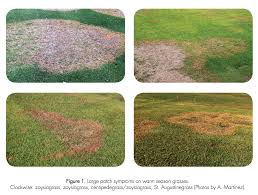It may not seem like it now, but moisture has played a big part in the current stress of centipede lawns. In recent months centipede grass was slow to green up in some places. Once it did, noticeable brown spots or patches began to appear prompting calls from homeowner and landscape professionals. After several homeowner visits, sample submissions and preparing slides to go under the microscope, one thing was apparent. The grass was experiencing environmental damage from all the moisture. This encouraged large patch which is caused by the soil borne fungus Rhizotonia solani. Large patch is secondary to the environmental damage.
Large patch is the most common and severe disease that affects warm season grasses in the spring and late fall. It is most apparent when the grass is entering winter dormancy or transitioning into spring green-up. Circular patches of affected turf can reach up to 26 feet in diameter. Leaves on the outer edges of the circle may appear bright yellow and/or orange in color. These patches may occur in the same spot year after year getting larger in diameter. The center of the patches develop thin and sunken areas that may fill in with weeds.

Large patch is favored by excessive moisture levels from rain and irrigation, continuous moisture for at least 48 hours, thatch layer between 50° and 70°F, poor drainage, cool summer weather, shade, and restricted air movement.
Before resorting to chemicals to control large patches try using some cultural control measures. This may mean revealing compaction by aeration, dethatching, correct poor drainage by installing drain tiles or improving soil porosity, adhere to proper mowing heights, and decrease shady areas.
If applying chemicals, fall applications are most effective. This is when most of the disease development occurs. Depending severity of the disease, spring application may be necessary to achieve control.
Rhizotonia large patch is the most common and severe disease of warm season grasses. However, it is manageable with a few strategies. They include:
Making sure areas are well-draining:
Preventing or correct soil compaction:
Implementing a sound fertility program:
Cutting grass at proper mowing height.
Applying fungicides at the right time of the year.
For more information or a chemical recommendation, please email me at morganjl@uga.edu or call at 229-436-7216.